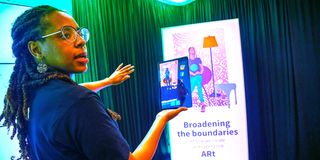
From left: Elsy Wameyo, Jane Arnison and Natasha Khanyola.
Women have been at the heart of music lately in Kenya: be it the likes of Maandy in hip hop, Njerae in R&B or deejays like Tina Ardor, Kaneda or Red Bone. And some like Elsy Wameyo and Xenia Manasseh are heavily involved in the production of the beats to their infectious hits.
At the Kilele Summit 2025, held in Nairobi, Jane Arnison, a 45-year-old accomplished music producer, composer, and sound artiste, took center stage, leaving a powerful impact on emerging artistes and highlighting the importance of female representation in the music industry. The event offered a platform for emerging artists to network, collaborate, and grow.
Arnison would take the opportunity to champion a new era in music where diversity, inclusion, and collaboration reign supreme. She discussed her approach to music production, collaboration, and the role of emerging technology in shaping the future of sound. Reflecting on the vibrant atmosphere, she said, “It’s inspiring to see so many young, passionate artists with so much to say. Being there, I realised how much potential there is in this community.”
Arnison spent years building a career that spans continents and creative mediums, continually pushing the boundaries of sound. In an industry often known for its competitive nature, Arnison emphasised that collaboration was the key to unlocking new ideas and driving artistic innovation.

Jane Arnison is a 45-year-old accomplished music producer, composer, and sound artiste.
“As projects get bigger, you simply can’t do it all alone. Collaboration is not just a necessity, but a way to ensure that the final product is greater than the sum of its parts. It’s about learning from others, sharing ideas, and growing together.”
Arnison was involved in multiple collaborations during the summit, including performances with artistes from Kenya and beyond. In particular, she was part of an experimental ensemble called Mizizi, a new cross-cultural live electronics music ensemble which featured Kenyan talents like singer-songwriter and Orutu player Labdi Ommes, live coder & electronic musician Monrhea composer and experimental vocalist Nyokabi Kariũki (KE).
Arnison also emphasised the importance of empowering women in the music industry, a cause she has long championed. She shared insights into the challenges women face, particularly in the male-dominated world of music production. With women representing a mere fraction of global music producers, Arnison stressed the need for visibility and support for female artists and producers.
“The industry is slowly changing, but we need to keep pushing for more opportunities and equal representation. Women must be given the same platform to succeed as their male counterparts.”
Arnison’s words were particularly impactful for local Kenyan female artists who saw her as a role model and a source of inspiration.
Early beginnings
Jane Arnison has spent much of her life immersed in the world of sound and music. She began her studies in classical composition at a Conservatorium in Sydney, Australia, before venturing into the film and television industries, where she sharpened her craft as a composer and sound designer.
Her approach to each project is shaped by the format and context, but always with the goal of making an emotional connection through sound.
“Music is a mode of human exchange,” she explains. “Whether you’re happy, sad, or somewhere in between, music is there. It’s a way to express complex feelings and ideas, and that’s what I love about it. It’s abstract, which makes it a perfect medium to explore these ideas.”
Arnison believes that collaboration is key to success in the ever-evolving music industry. As projects grow larger and more complex, she emphasises the importance of building creative partnerships. Working with people who share your vision and inspire you leads to the most successful collaborations.
“Collaboration is essential,” she says. “As the projects get bigger, it’s impossible to do everything yourself. You need to work with people whose strengths complement yours. When you respect each other and share ideas, the work becomes easier and more enjoyable.”
Empowering Women in Music
One of Arnison’s key missions is to elevate women in the music industry, an area where women are still underrepresented. Globally, less than five percent of music producers are women, a statistic that highlights the challenges women face in gaining visibility and opportunities.
“I want to make sure that women have the same opportunities I’ve had,” Arnison states. “It’s not just about visibility, it’s about giving them the tools and support to succeed. I work on education initiatives to help women develop their skills and build their confidence. It’s about making sure they know they belong in this space.”
Arnison’s efforts also include initiatives to encourage men to collaborate with female producers. “It’s important to support women working with women, but we also need men to embrace working with women in the industry,” she explains. “It’s about creating an inclusive environment where everyone has equal opportunities to succeed.”
The role of technology in her music
As someone who is deeply fascinated by technology, Arnison is always on the cutting edge of new developments in the music industry. From spatial audio and Dolby Atmos to immersive sound design, she views technology as a tool to enhance the way music is experienced, rather than as the focus of her work.
“Technology is just a tool,” she says. “The music and the message are the core of what we are doing. It’s important to use technology to communicate ideas, but if you get too caught up in the tools themselves, you lose the connection to the music. It’s about striking a balance.”
Her interest in new technologies, particularly in the realm of immersive sound, has led her to explore how space and acoustics affect the way we perceive music. Whether it’s designing the layout of a room for an installation or experimenting with new forms of spatial audio, Arnison is always thinking about how to create the most impactful listening experience.
“Sound needs space to exist,” she says. “When you’re designing immersive experiences, you have to consider the natural acoustics of the space and how people will move through it. The interaction between the audience and the sound is just as important as the sound itself.”
Facing challenges and building opportunities
The music industry is notoriously challenging, particularly for women, and Arnison has faced her share of obstacles along the way. From battling for equal pay to navigating the complexities of being taken seriously as a female producer, she has learned to persevere and adapt.
“I’ve faced challenges with getting work and not being paid as much as others,” she admits. “But I’ve learned to diversify my work. I have many different ways to earn a living, and that has given me the opportunity to stay creative and continue pursuing my passion.”
Patience has also been key to her success. “It takes time to build respect and trust in the industry,” she reflects. “But if you stay focused on the music and let your work speak for itself, the opportunities will come.”
Giving Back and Looking Ahead
Through her work as an educator, Arnison has mentored countless aspiring producers and musicians, answering their questions and offering guidance. She is also writing a technical book on music mixing, drawing on her years of experience and teaching to help others learn the craft.
Her impact extends beyond education. Arnison has formed strong connections with artistes in Kenya and has already begun planning future collaborations. “I’m excited about the future,” she says. “There’s so much talent here, and I’m looking forward to working with even more incredible artistes.”
Her advice to others: “Learn your craft, be confident, and don’t be afraid to take risks. Keep pushing forward, and trust that the opportunities will come.”
Natasha Khanyola, a Creative Technologist, who was at the summit, found it to be an incredible experience. She described it as more than just a music festival. “Having a summit that was not just about music, but also music technology, music education, and making connections between the music makers and the music technology industry, was amazing.”

Natasha Khanyola is a creative technologist.
Meeting passionate music makers and creative technologists was one of the highlights for Natasha. She described it as “a once-in-a-lifetime experience,” and it was the highlight of her year.
Attending the panel on film scoring opened her perspective on varied ways of score creation, especially using layered vocals to create a score in the absence of instruments or other technology. She realised how versatile the voice is and reflected, “The talk showed how diverse the voice is as an instrument and all the ways that I have let it go underutilised in my film sound design practice.” Natasha also made valuable connections at the summit, inspiring her to pursue further studies, including potentially applying for a PhD in creative technology in the future.”

Kenyan Australian singer, rapper and producer, Elsy Wameyo.
Kenyan artiste Elsy Wameyo, also featured at the summit. Elsy has gained international recognition for her genre-defying blend of soul-infused hip-hop and alt-R&B with her critically acclaimed debut EP, Nilotic (2022) and debut album made in Kenya, Saint Sinner (2024). She has also been prominently touring in Australia, The UK and other parts of Europe for the sound she created while trying to find a way to keep in touch with her roots as a Kenyan who grew up in Australia.






